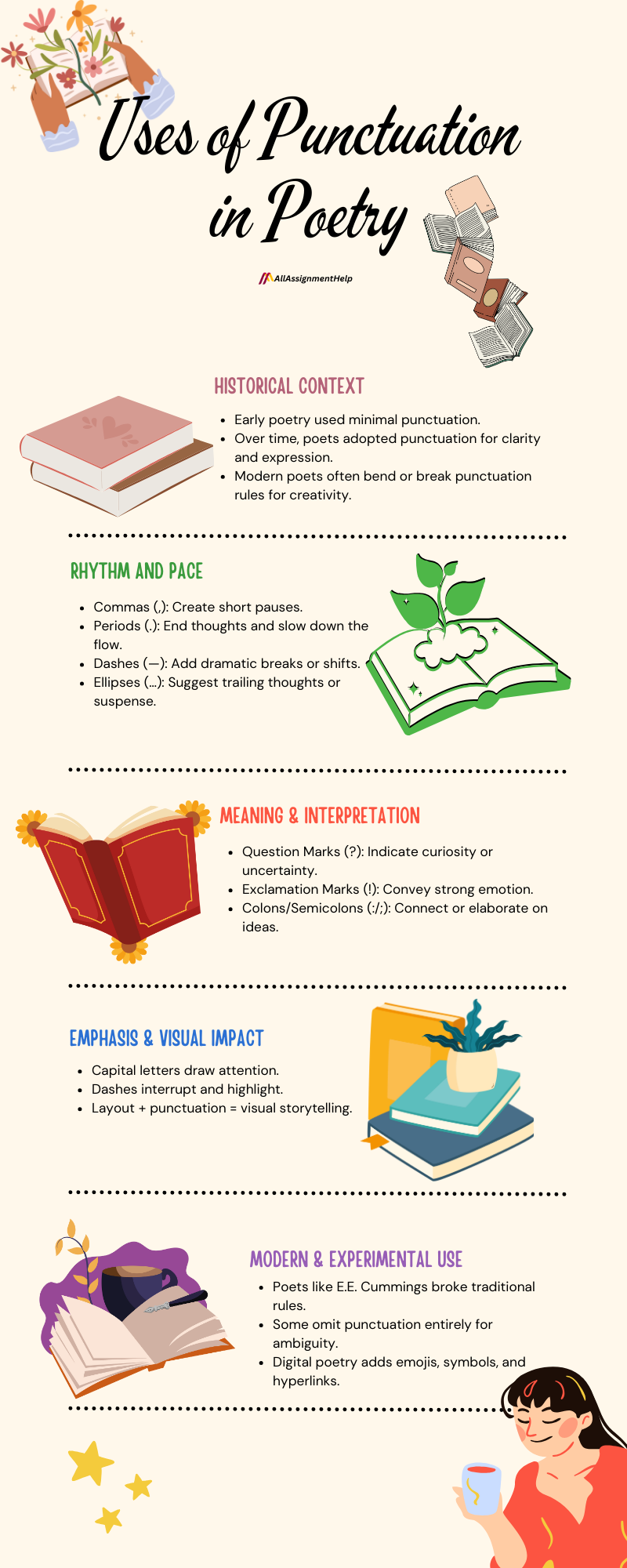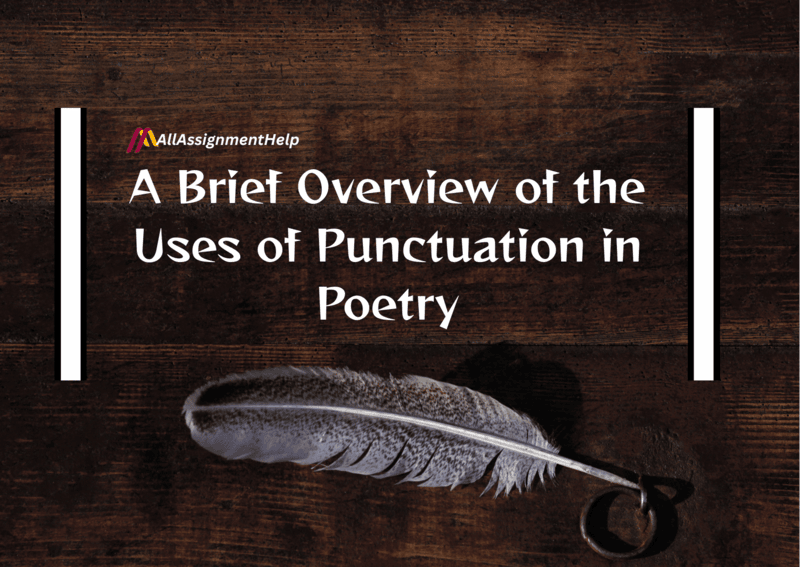Table of Contents
Punctuation should be used as a clarity device in writing, leading the reader throughout the script and the progression of phrases. In poetry, punctuation is far nimbler and performs multiple roles, controlling not just the rhythm and flow of the poem but its sense and emotional register too. As a result, prose is largely dependent on punctuation for basic semantics and readability, while poetry has more liberty in how it utilises punctuation. Poets regularly play with punctuation marks to express moods, create pauses, etc.
Additionally, punctuation is not a set of rules to be followed in poetry; it is a tool for expression. From the purposeful halt introduced by a comma to the jarring cut of an exclamation mark, punctuation can take an ordinary phrase and turn it into something dense with feeling and subtlety. Considering the purpose and effect of punctuation in poetry expands our understanding of the poet’s craft and enriches the reading experience. In this blog by All Assignment Help, we will delve into the different uses of punctuation in poetry, from how it has evolved over the years to how experimental poets of today are reworking it.
Historical Context of Punctuation in Poetry
Punctuation also has a long history in poetry, and it has seen several reversals over the decades. While punctuation features heavily in poetry, this has not always been the case. Especially not in any early or classical, or mediaeval texts, in which punctuation was scant or entirely nonexistent. Punctuation marks, as we know them today, were not in widespread use among the ancient poets. Moreover, punctuation as a feature of written language began in the 12th century, as guided by scholars like Alcuin of York, who created an early system of symbols to help readers determine how to read written texts. Understanding the historical context of punctuation in poetry can also help with assignment writing. Having in-depth knowledge will always help you in making the right and best use of all the punctuation marks.
It was not until the 16th and 17th centuries that punctuation began to take a more regularised form, largely thanks to the printing press. At this time, poets such as John Milton and William Shakespeare were more deliberate about adding punctuation to their work, making use of commas, periods, and question marks to aid the reader with pacing. Furthermore, in the 18th and 19th centuries, punctuation was integral to the poetic structure, as it was for much of the Romantic period. For poets like William Blake and Emily Dickinson, punctuation was used to create emotional heft through breaks, pauses, and unconventional punctuation to guide readers to read and interpret their poems in certain ways.
Also read: British Literature and Its Division into Various Periods
Punctuation as a Tool for Rhythm and Pace
Punctuation is the way that we manage the pace and tempo of a poem. Each word, line, and even pause is placed intentionally. A punctuation mark adds another layer of meaning to the rhythm and flow. The placement of commas, periods, and dashes directly affects how slowly or quickly the reader reads through the poem, and the poet can use these implements as tools to pace and control the emotional intensity of the poetry.
Function of different punctuation marks
For instance, commas form these tiny breaks of space where they can breathe and reflect and where a moment will have space resonance. If commas are used a lot in a sentence, they slow the reading and encourage more deep consideration compared to a sentence with fewer commas. Periods are the same. They act like full stops and provide the definite end of a thought or an idea. Furthermore, they add to the level of finality or completeness a poem may carry. Periods serve a strategic purpose for poets, who use periods to parse their material into smaller, more manageable units of control. So, for example, an ellipsis (…) can show an unfinished thought or a trailing-off thought, which can build tension and anticipation. A dash will generally and abruptly change the course of the thought, producing a break or dramatic pause.
In addition to this, learning punctuation in poetry through and through and using it rightfully might take you some time. Moreover, you also need to practice regularly. As a result, there is a chance of imbalance between your academic and other social or personal responsibilities. Hence, you can use online class help and online assignment help services for assistance with assignment writing, taking online lectures on your behalf, and combating a lot more academic obligations. In this way, you can keep learning and practising punctuation without worrying about other academic duties.
Also read: Modern Period in English Literature

Punctuation and Interpretation of Meaning
Punctuation in poetry plays a huge role in how a poem is read because changing the punctuation of any given line can lead to quite a different idea or emotion. Moreover, punctuation is structural in prose, but it has semantic value in poetry, taking on a role much like a stylistic guide to help the reader interpret the poet’s intentions. The use of punctuation can bring forth clarity in assertion, ambiguity, or interpretation.
Expressing emotion through punctuation
As an example, if you think or wonder, you use question marks. A question mark uses a statement and asks the reader to consider what that statement means or to question the idea. Even if you are stressed and asking questions like, should someone take my online exam for me now or later?” the punctuation conveys your hesitation here. Another type of strong punctuation that conveys a heightened emotion, excitement, or urgency is an exclamation mark.
An exclamation point at the end of a line adds excitement to the tone, urging the reader to read that line with more dramatic emphasis. A little punctuation can do great things in determining the emotion or tone of a poem. Moreover, the colon and semicolon are less frequently seen but change the reading. A colon usually precedes lists or further explanations. Whilst semicolons provide continuity between closely related ideas without sounding conclusive as a period does. These punctuation marks assist the poet in conveying her thread of thoughts in such a manner that the reader can psychologically and emotionally lean on it.
In poetry, punctuation ceases to be a simple observance of grammatical mandates and transforms into the constituent eye in the prose amidst the stanzas.
Emphasis and Visual Impact of Punctuation
Stylistically, punctuation in poetry is not just for function. It can also be used as a tool for emphasis and visual interest. Punctuation marks help poets guide readers, call out something, and control how it looks on the page. The dialogue between punctuation and form is also a fundamental way a poem conveys its meaning and effect. Moreover, capital letters, dashes, and ellipses are among the most frequent punctuation marks that inject emphasis. Furthermore, through English homework help, you can explore more of these elements. It will also help you in deeply understanding the insights that major stylistic choices can affect the meaning and tone of a poem.
Capitalisation can be used for effect, emphasising important words/phrases, indicating a change in tone, or denoting an important moment in the poem. Moreover, dashes provide a jump cut, which focuses the reader on the forthcoming words. They also increase the emotional stakes in a line, leaving space for the reader to ponder its denouement.
Another punctuation mark that also serves as a visual indication of a near-phonetic statement is ellipses (…). It communicates an incomplete thought or an unfinished trail-off, suggesting tension or ambiguity. This can often be left open to interpretation, allowing the reader to fill in the blanks of what they think happened or how they feel. Meanwhile, lines that end with a period or a comma feel more contained, forcing a clarity that affects both the visual and emotional reading of a poem.
Modern and Experimental Uses of Punctuation in Poetry
In modern poetry, we use punctuation to bypass traditional constraints, which allows poetry to test the limits of meaning, form, and expression. As we moved through the 20th and into the 21st century, poets began experimenting more and more with punctuation, using it not simply to punctuate their thoughts but to express deeper emotions, fragmented thoughts, and non-linear narratives. This experimentation opens new possibilities on how language works and engages with its reader.
The experimental edge of modern and digital poetry
No better example of this is there than E.E. Cummings, who epitomised modernism with his often pseudo-minimalist and quirky use of punctuation. Cummings broke much of the customary syntax, removing periods and commas from his lines or misusing the punctuation at hand to trip readers up on his lines. His complete abandonment of punctuation was intentional, leaving things open-ended, and the reader has the option of interpreting the poem in several different ways, according to how the reader wants to read it.
In the same way, poets such as Gertrude Stein and William Burroughs adopted experimental punctuation as a method of rendering discontinuous or fragmented thought, such that the surreal or abstract quality of an image would add another level of meaning to it. Their poems have dashes and ellipses, capturing breaks in thought or a sense of dislocation, or attempting to reflect the mind itself. Moreover, having a sound knowledge of punctuation in modern and digital poetry will also benefit you in your English literature homework.
Punctuation is also changing in digital poetry. As poetry reading has moved to the screen with the rise of internet poetry, poets play with punctuation as part of the visual and dynamic nature of their poetry. Traditional punctuation has also changed with the use of hyperlinks, emojis, and text size, helping convey meaning in a new way.
Conclusion
Emerging from writing conventions, punctuation in poetry is a poetic device that can manipulate tempo, emotion, and meaning. Moreover, punctuation aids in the delivery of a poem, from pace control to interpretation guidance. Furthermore, it assists the poet in their delivery. However we use it in fashion, but in traditional or experimental shape, it will serve as one of the primary determinants of how we experience a poem. Poets offer marks of punctuation like commas, dashes, and ellipses as tools to add depth and clarity or a bit of deliberate ambiguity to parse. An understanding of how punctuation works helps in the appreciation of poetry, where every pause, stop, or break in the rhythm of words is a crucial part of the whole poetic experience.
Frequently Asked Questions
Question: Why is punctuation important in poetry?
Answer: Punctuation in poetry brews rhythm, meaning, and emotional tone. It sets the pace, adds tension, and dictates to the reader how to read the poem.
Question: In what way does punctuation influence the rhythm of a poem?
Answer: Lines and punctuation, commas, and periods affect how fast and free or slow and clipped a poem unfurls. Commas slow things down, periods bring them to a halt, and dashes introduce pauses or changes.
Question: How important is punctuation in conveying emotion in poetry?
Answer: Exclamation marks and question marks emphasise the emotional tone, while ellipses and dashes provide suspense or some notion of an unfinished thought, giving a tone to the poem.
Question: What creative uses of punctuation and spacing can we find in modern poetry?
Answer: Contemporary poets frequently break traditional punctuation rules to develop more personalised effects. They use dashes, ellipses, and sparse punctuation to develop more meaning and encourage reader engagement differently.
